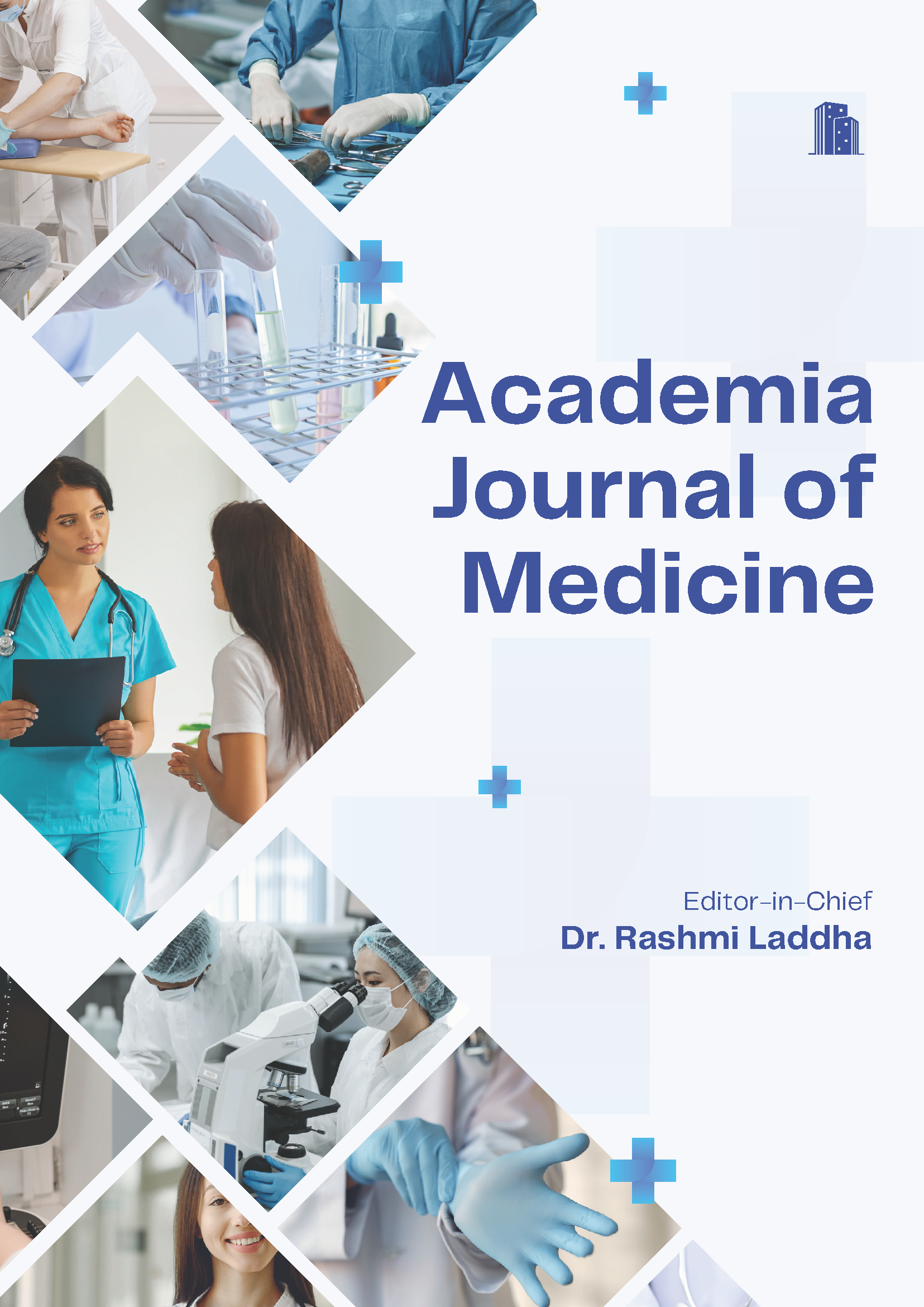Association between High Density Lipoprotein (HDL) and Glycosylated Haemoglobin (HbA1c) in Type 2 Diabetes Mellitus Patients Undergoing Angiography for Acute Coronary Syndrome
Keywords:
High Density Lipoprotein, Glycosylated Haemoglobin, Diabetes MellitusAbstract
Background: To evaluate association between high density lipoprotein (HDL) and glycosylated hemoglobin (HbA1c) in type 2 diabetes mellitus patients undergoing angiography for Acute Coronary Syndrome (ACS). Subjects and Methods : Type 2 Diabetic patients who presented with Acute Coronary Syndrome were subjected to Angiography and Comparison of HDL & HbA1c level in view of single vessel or multi vessel Coronary Artery Disease was done to Evaluate association/correlation between HDL & HbA1c level with single/multi vessel Coronary Artery Disease. Result: In present study out of 90 subjects who have undergone C.A.G, 29 (32.22%) had S.V.D and 61 (67.78%) had M.V.D. In present study no. of male patients with S.V.D was 22 (75.86%) and females were 7 (24.14%). Whereas, no. of male patients with M.V.D were 45 (73.77%) and females were 16 (26.23%). Maximum no. of patients with S.V.D belong to age group <40 years (n=11, 37.93%). Maximum no. of patients with M.V.D belong to age group 51-60 years (n=26, 42.62%), Maximum patients had S.T.E.M.I i.e., n=73 (81.11%), whereas N.S.T.E.M.I was present in only 17 patients (18.89%). Among those with S.V.D, 72.41% (n=21) had HbA1c 6.5 to 8.4 and among 27.59% (n=8) had HbA1c >8.5. Among those with Multi vessel disease, 68.85% (n=42) had HbA1c >8.5 and 31.15% (n=19) had HbA1c of 6.5 to 8.4. There was significant inverse correlation present between level of H.D.L and number of vessel involved. Most of the patients with L.D.L ≥100 had Multi vessel disease (n=53, 86.99%). Conclusion: The severity of A.C.S, as measured by a single or multi-vessel disease on coronary angiography, is directly linked to poor glycemic management, as measured by a higher HbA1c. The severity of A.C.S is also linked to an abnormal lipid profile, such as elevated L.D.L and low-H.D.L.
Downloads
References
1. Kumar A, Cannon CP. Acute coronary syndromes: diagnosis and management, part I. Mayo Clin Proc. 2009;84(10):917– 938. Available from: https://doi.org/10.1016/s0025-6196(11) 60509-0.
2. Pant DC, Mowar AB, Chandra N. Co-relation Between Total Cholesterol, High Density Lipoprotein, Low Density
Lipoprotein and Glycosylated Haemoglobin (HbA1c) in Dia betic Patients with Acute Coronary Syndrome (ACS). J Assoc Physicians India. 2018;66(7):20–22.
3. Hajar R. Risk Factors for Coronary Artery Disease: His torical Perspectives. Heart Views. 2017;18(3):109–114. Available from: https://dx.doi.org/10.4103/HEARTVIEWS. HEARTVIEWS_106_17.
4. Dar MI, Beig JR, Shah JI, Ali TR, Rather M, Tramboo HA, et al. Prevalence of type 2 diabetes mellitus and association of HbA1c with severity of coronary artery disease in patients presenting as non-diabetic acute coronary syndrome. Egyptian Heart J. 2020;72(1):1–8.
5. Joshi SR, Parikh RM. India - diabetes capital of the world: now heading towards hypertension. J Assoc Physicians India. 2007;55:323–324.
6. Kumar A, Goel MK, Jain RB, Khanna P, Chaudhary V. India towards diabetes control: Key issues. Australas Med J. 2013;6(10):524–531. Available from: https://doi.org/10.4066/ amj.2013.1791.
7. Selvin E, Steffes MW, Zhu H, Matsushita K, Wagenknecht L, Pankow J, et al. Glycated hemoglobin, diabetes, and cardiovascular risk in nondiabetic adults. New Eng J Med. 2010;362(9):800–811. Available from: https://doi.org/10. 1056/nejmoa0908359.
8. Timmer JR, Hoekstra M, Nijsten MW, Van Der Horst IC, Ottervanger JP, Slingerland RJ, et al. Prognostic value of admission glycosylated hemoglobin and glucose in nondiabetic patients with ST-segment-elevation myocardial infarction treated with percutaneous coronary intervention. Circulation. 2011;124(6):704–711. Available from: https://doi. org/10.1161/circulationaha.110.985911.
9. Wilhelmsen L, Welin L, Svardsudd K. Secular changes in cardiovascular risk factors and attack rate of myocardial infarction among men aged 50 in Gothenburg, Sweden. Accurate prediction using risk models. J Intern Med. 2008;263(6):636–643. Available from: https://doi.org/10. 1111/j.1365-2796.2008.01931.x.
10. Yeh RW, Sidney S, Chandra M. Population trends in the incidence and outcomes of acute myocardial infarction. N Engl J Med. 2010;362(23):2155–2165. Available from: https: //doi.org/10.1056/nejmoa0908610.
11. Baligar B, Mamatarani RH, Hiregoudar NS. Comparison of HbA1C and lipid profile with severity of coronary artery disease in diabetic patients presenting with acute syndrome. J Evid Based Med Healthc. 2019;6(46):2940–2944. Available from: http://dx.doi.org/10.18410/jebmh/2019/613.
12. Hu C, Zhang J, Liu J, Liu Y, Gao A, Zhu Y. Discordance between the triglyceride glucose index and fasting plasma glu cose or HbA1C in patients with acute coronary syndrome undergoing percutaneous coronary intervention predicts cardio vascular events: a cohort study from China. Cardiovasc Dia betol. 2020;19(1):116. Available from: https://doi.org/10.1186/ s12933-020-01091-8.
13. Wang X, Han Z, Hao G, Li Y, Dong X, Wang C. Hemoglobin A1c level is not related to the severity of atherosclerosis in patients with acute coronary syndrome. Dis Markers. 2015;2015:192108. Available from: https://doi.org/10.1155/ 2015/192108.
